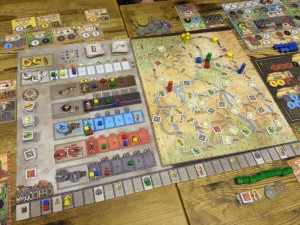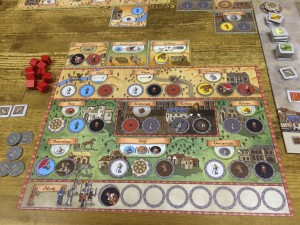Review: Orléans
Posted by James (admin) on March 25th, 2015

The main board with the different character tracks on the left, the roads/rivers/cities where players move and build trading posts on the right, and development track across the bottom.
Orléans is from dlp games who released the highly-entertaining game Citrus last year. Orléans combines multiple game mechanics such as bag-building, meeple movement, and worker placement.
Each player has a bag of character tokens (farmers, knights, craftsmen, etc.) and players will add more tokens to their bag during the game. At the start of each round, players draw some characters from their bag, and each player places them on their player boards in specific combinations to activate actions. Most actions require 2 or 3 characters to activate them so there are often tricky choices deciding in which combinations to allocate the drawn characters each turn. Players can part-fill actions and complete them on a later turn too.
There are lots of different actions to choose from. Many add a character to your bag and then advance you along the matching track on the central game board which give a benefit – the further along a track you are, the better the benefit. For example, adding a boatman to your bag advances you along the boatman track which earns you coins. Adding a knight to your bag also advances you along the knight track which allows you to draw more characters at the start of each round. Adding a trader to your bag allows you to take one of the building tiles and you can use the special action on it from then onwards – some special actions are cheaper versions of the main actions, but most are special abilities such as creating goods, or using a boatman character as a craftsman/farmer/trader instead.

A player board where they allocate their characters to perform actions. Note this player has gained 3 building tiles at the top too which give them extra possible actions.
There is also opportunity for direct interaction between players too. Some actions allow you to move your merchant (meeple) around the map. The merchant can move along a road or a river, depending upon which action was activated (each requiring a different mixture of characters), and they gain a goods tile if they pass over one along a route. Also, you can use an action to build a trading station where your merchant is located, but there can only be one trading station per location so you need to build there before someone else does. Merchant stations are worth VP at the end of the game.
When you use an action, the characters used to activate it go back into your bag, so your characters are constant recycled, as well as adding new ones too. So, this is a bit like deck-building but with tokens being drawn from a bag – bag-building. (Another release this year, Hyperborea, has a similar type of mechanic using cubes.) There are a few other game elements worth mentioning too such as the Beneficial Deeds board where players permanently place characters (removing them from their bag for good) which can earn a reward.
At the end of each round, all players resolve the effects of an event tile (drawn at the start of each round) which can be good or bad. The game ends after 18 rounds and the player with the most Victory Points (VPs) wins. Players earn VPs for cash, goods, trading stations, and citizen tiles (which are earned by the first player to reach some spaces on some tracks). The amount of VPs for each trading station and citizen tile is based on a player’s progress along the development track.
 Orléans is an excellent Euro game which contains lots of different elements which you need to balance in order to score VPs. Choosing how to allocate the characters you draw is a very interesting decision process as you work out what you can achieve, especially later in the game when you’re drawing more characters at once. Not only do you need to work out which actions you want to perform (especially as some items are limited and other players may grab them first), but you need to work out what actions you’re actually able to perform . There’s always the temptation to use characters to immediately fill/perform actions, but sometimes it’s better to partially fill actions which may be more useful to you so they can be completed later by drawing the other characters required.
Orléans is an excellent Euro game which contains lots of different elements which you need to balance in order to score VPs. Choosing how to allocate the characters you draw is a very interesting decision process as you work out what you can achieve, especially later in the game when you’re drawing more characters at once. Not only do you need to work out which actions you want to perform (especially as some items are limited and other players may grab them first), but you need to work out what actions you’re actually able to perform . There’s always the temptation to use characters to immediately fill/perform actions, but sometimes it’s better to partially fill actions which may be more useful to you so they can be completed later by drawing the other characters required.
Some of the tracks give you improved abilities such as drawing more characters each turn, and this sort of upgrading reminds me a bit of Hansa Teutonica (which is a good thing), plus it adds some progression to the game too. Gaining lots of one character type may move you a long way up the relevant track and gain the benefit, but this can make activating actions each turn difficult as your bag will have lots of one character type in it and actions require a mix of character types.
There are various developmental routes you can pursue, but it feels that none can be completely disregarded either. Upgrading your abilities, changing the mix of characters in your bag, gaining extra action tiles, building/moving on the map, and advancing along the development track are all important, but you can’t do everything so need to find a balance. Your choice of balance often needs to factor in what other players are doing too as they may be after the same limited character tokens, building tiles, locations on the map, etc. This is especially important because if all the character tokens of one type have been taken then no player can take that action which means they can’t advance along that track and improve their abilities.
As well as adding (and removing) characters, you can customise your position further by gaining building tiles. These contain some good variety but I like that they’re not essential to all strategies. Another way to customise your abilities is by using an action to place a technology marker on 1 character space so that it counts as being permanently filled. As there are lots of ways you can customise your capabilities, each player starts to develop slightly different perspectives of the game, which is something I always like.
The game plays well with 2 players – there’s a very fast turn around – although I think I prefer it with 3 or 4 as there’s more competition over the characters, the building tiles, filling the Beneficial Deeds board, who has the most farmers (as there’s a reward/penalty for having the most/fewest farmers each round), etc. The game moves pretty quickly, especially (a) earlier in the game when you can only draw a few characters, and (b) because players usually allocate their characters simultaneously (although you can do it in turn order if what one player allocates would make a difference to the next player.
I think there are a couple of minor issues. One is that some of the building tiles seem obviously more powerful than some others to me. The other is that a couple of items seemed too powerful but these were solved with house rules which, in my opinion, felt more balanced. [One was that the bathhouse let’s you draw 2 keep 1 character (instead of draw 3 and keep 2), and technology tokens could only be placed on your player board and not on any of the extra building action tiles.]
Overall, Orléans was one of my favourite games of Essen 2014. I really like the short-term decision-making whilst still needing an overall plan. Balancing what’s in your bag is important (although don’t take that from me, take it from the designer as he told me that), and I find it a challenge whilst still being able to have a strategy. You can read more info and the rules on dlp game’s website here: bga.me/orleans
James.
[Played with 2 and 4 players]

